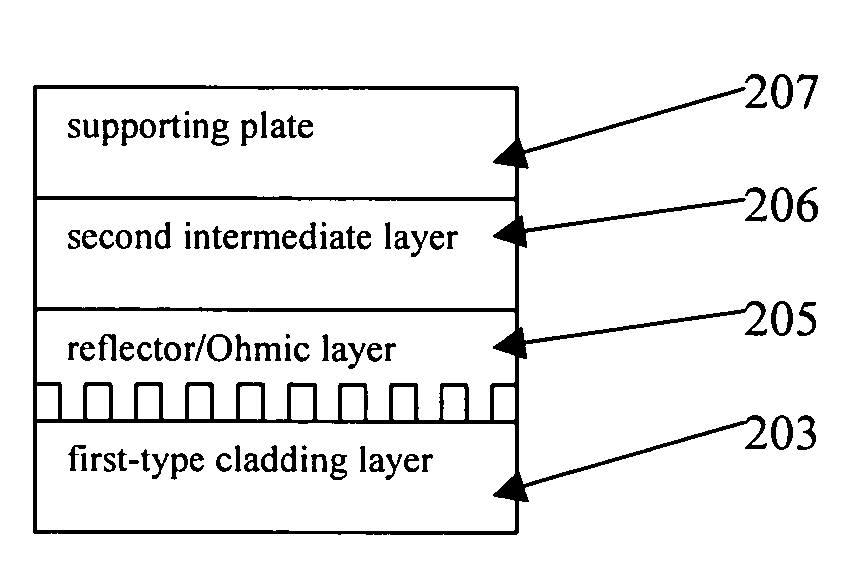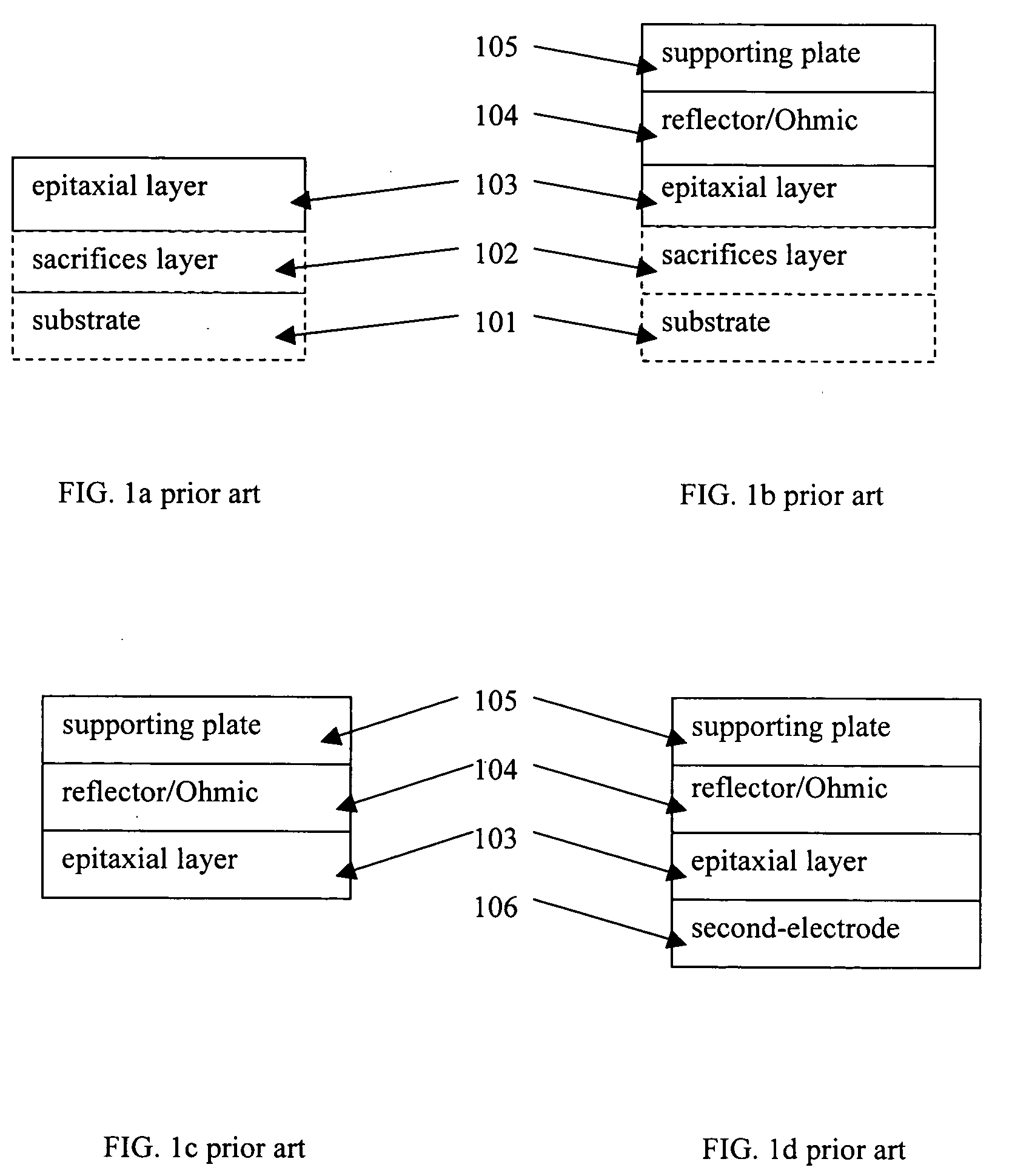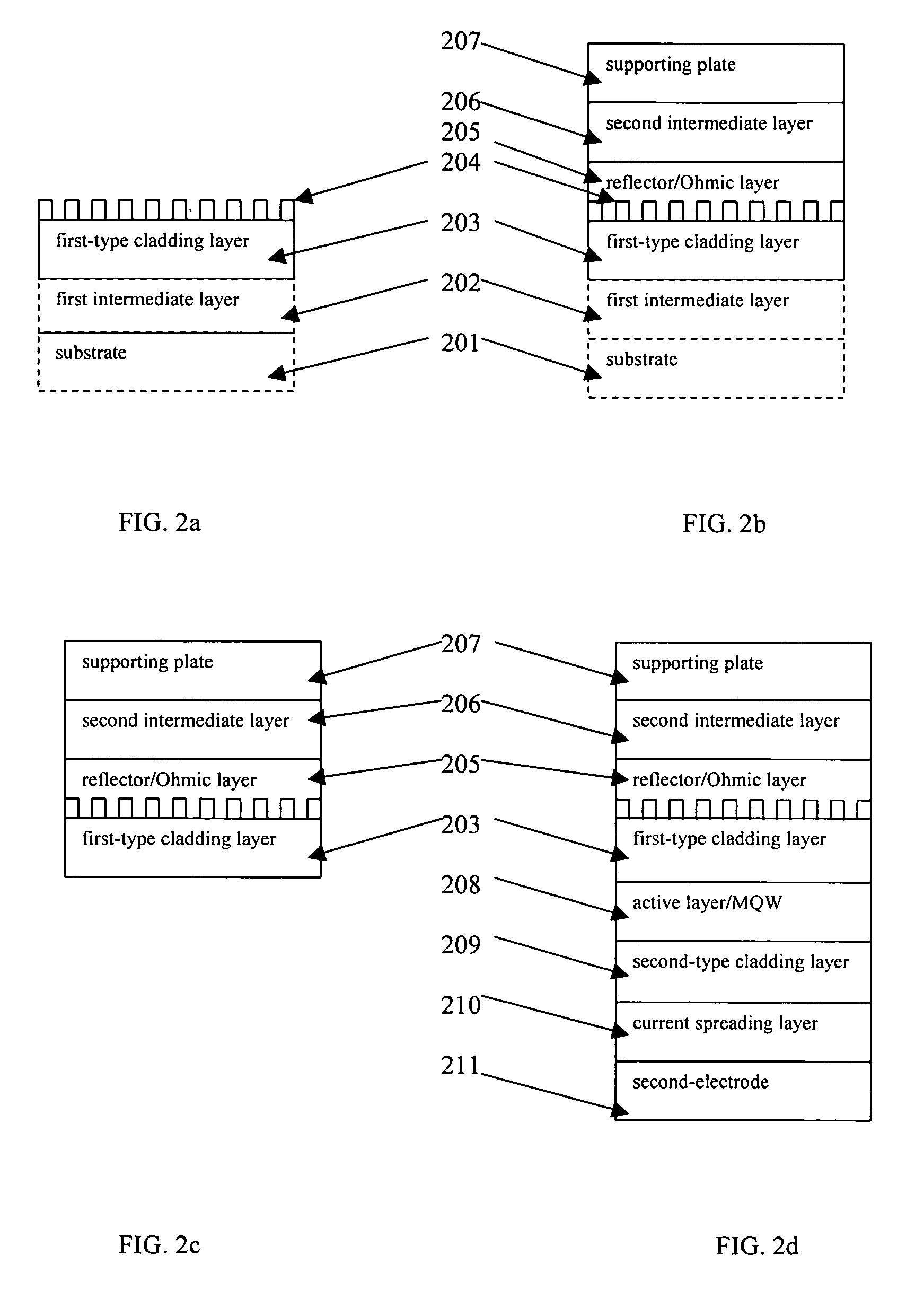Vertical semiconductor devices or chips and method of mass production of the same
a technology of semiconductor chips and semiconductor chips, applied in the direction of semiconductor devices, basic electric elements, electrical equipment, etc., can solve the problems of increasing the chance of damaging the epitaxial layer of leds, reducing the throughput, and high cost of laser lift-off equipment, etc., to achieve fast heat dissipation, high cost, and complex process
- Summary
- Abstract
- Description
- Claims
- Application Information
AI Technical Summary
Benefits of technology
Problems solved by technology
Method used
Image
Examples
first embodiment
FIG. 2a to 2g
[0055] The selections of a structure and a material of first intermediate layer 202 depend on the selection of both a substrate removing process and a material of substrate 201. For different substrate removing processes, the structure and material of first intermediate layer 202 are different
[0056] For GaN based LEDs, a common choice of substrate 201 is a sapphire substrate. Two processes to remove sapphire substrate 201 are disclosed.
[0057] The first sapphire substrate removing process is to remove both sapphire substrate 201 and first intermediate layer 202 by precisely lapping / polishing before growing an epitaxial layer comprising an active layer. First intermediate layer 202 comprises one or multiple buffer layers. First-type cladding layer 203 is grown on the top of the buffer layers, and preferably is an n-type cladding layer. Textured top surface 204 of first-type cladding layer 203 is formed by either dry or wet etching (details is disclosed in FIG. 4) for s...
third embodiment
FIG. 3a to FIG. 3d
[0070] For GaN based LEDs, first intermediate layer 302 serves as a buffer layer comprising AlN and GaN buffer layers growing on the (111) plane of Si substrate 301. To grow AIN, firstly, chemically clean polished Si substrate 301. Secondly, growing AlN single crystalline layer at 1100-1250 degree C. for thickness of about 100-200 nm and obtaining smooth and featureless surface. Thirdly, growing GaN buffer layer at temperature of 1050 degree C. Then first-type cladding layer 303 is grown on GaN buffer layer.
[0071] The process steps of texturing the top surface of first-type cladding layer 303, disposing reflector / Ohmic layer 305, disposing second intermediate layer 306, disposing supporting plate 307, removing Si substrate 301 and first intermediate layer 302, disposing a first-type cladding thin film of first-type cladding layer 303, growing active layer 3308 and second-type cladding layer 309, disposing current spreading layer 310 and patterned second-electrode...
fourth embodiment
FIG. 3e
[0073] An n-type AlGaN thin film (for example, Al.sub.0.07Ga.sub.0.93N having an electron density of 3.times.10.sup.17 / cm.sup.3), as a first-type cladding layer 303, may be directly grown (at about 1000 degree C.) on Si substrate 301. The rest process steps, starting with the process steps of texturing the top surface of first-type cladding layer 303 to the process step of disposing patterned second-electrode, are the same as that of the first embodiment of FIG. 3a to FIG. 3d.
[0074]FIG. 4a is a top view of textured top surface 400 formed by etching the top surface of first-type cladding layers 203 or 303 respectively. Textured top surface 400 comprises two types: mesa-type and well-type.
[0075]FIG. 4b is a cross sectional view of an embodiment of mesa-type textured top surfaces 400. Textured top surface 400 has mesa 402a and well-separator 401a, it is preferred to form mesa 402a having the same dimension as that of a semiconductor devise or chip, and to form well-separator ...
PUM
 Login to View More
Login to View More Abstract
Description
Claims
Application Information
 Login to View More
Login to View More - R&D
- Intellectual Property
- Life Sciences
- Materials
- Tech Scout
- Unparalleled Data Quality
- Higher Quality Content
- 60% Fewer Hallucinations
Browse by: Latest US Patents, China's latest patents, Technical Efficacy Thesaurus, Application Domain, Technology Topic, Popular Technical Reports.
© 2025 PatSnap. All rights reserved.Legal|Privacy policy|Modern Slavery Act Transparency Statement|Sitemap|About US| Contact US: help@patsnap.com



